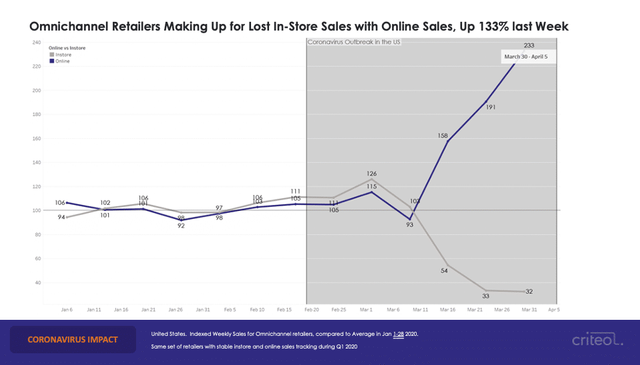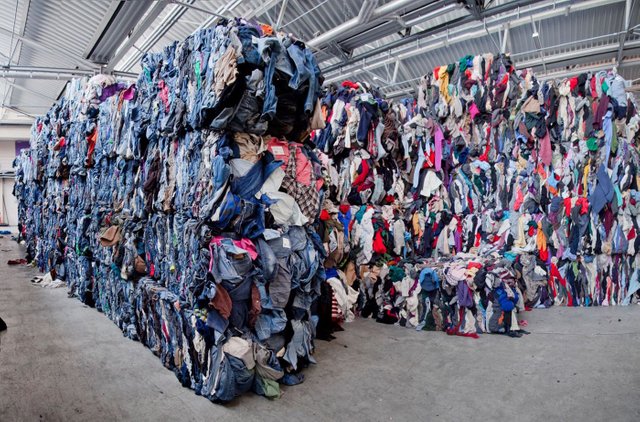
Luxury fashion is a longstanding tradition. The continually resurfacing Marie Antoinette or Cleopatra motifs in haute couture show just a portion of how far back this history goes. However, while styles change and reappear, the concept of luxury fashion is more or less the same: high quality clothing with the latest designs.

For years now, though, fashion tech has been promising a change to this. Luxury clothing that can do more and link the digital and the physical realm has been teased for decades. In fact, this is one of the most popular themes in sci-fi — which seems silly to point to, I know, but this is how we define our imagined future.
But, while a lot of design goes into technology, and design is obviously at the centre of fashion, the two have yet to really come together. Technology has often been too clunky, dissimilar to fabric, or expensive to be largely adopted. So far, it’s only been fleetingly embraced as a design element in clothing.
This is a bit counter-intuitive, though. Technology is increasingly incorporated into our lives. Wearable fashion is less of an alien concept. In fact, for those of us who grew up with a smartphone in our hand, the fact that our clothing cannot replicate the intuitiveness and ease-of-use of the rest of our technology enabled lives, is often the alien concept.
All of this is to say that we finally seem to have hit the tipping point — implementing technology into our fashion is the final hurdle for luxury fashion to truly and indisputably solidify what sets it apart from fashion with lower price tags.
Benefits Beyond the Consumer
However, these benefits are not only there for the wearer. Increasingly, technology is being embraced by the cleanest and greenest manufacturers. The future of fashion tech — and luxury fashion — looks like widespread sustainable and ethical practices.
But, just what technology will enable this?
There is a lot of different technology that can be used throughout the fashion industry. While higher performing materials and better production methods are continually being designed, AI, blockchain, and IoT (Internet of Things) also have a role to play. These technologies enable better practices both during manufacturing and post-sales.
The Hidden Cost of Online Shopping
2020, with the Covid-19 punch to the gut, had many markets reeling. And, while online retail was useful, and perhaps even relaxing, for many of us, it is not without its problems.

Aside from the obvious and life-threatening strain that this placed on delivery personnel, there are also some less clear issues.
No matter how closely you read online size charts, there are always variations in how items fit. The rate of return for online retail is 40%, and this goes up to 50% when consumers factor this in to order multiple sizes. The logistics of all of these individual deliveries adds up, and significantly increases CO2 emissions based on delivery fleets — especially with more global orders. Think of the emissions involved in shipping a dress from a Chinese retailer to a US consumer. And, then, having to turn around and ship it back. Flight emissions are not small potatoes and this adds to that doubly.
Gulnaz Khusainova, Founder and CEO of Easysize, a platform that uses AI to monitor returns, told us that:
‘high returns […has] been the problem for a long time but has been overlooked by many as a necessary cost of doing business. Now [with Covid-19,] companies are more focused on profitability and are looking at returns as a major source of expenses and are interested in solutions that would address that’. Khusainova continues that ‘[t]echnologies that were interesting but perhaps less prioritised by companies are in high demand now if they can really move the needle’.
And, at the moment, this is where AI is making a great deal of advancements. AI can be used for “virtual fittings” that take into account to some extent the drape of the material over your measurements. One retailer, Moosejaw, reported that the returns of their online sales dropped to 24% after they implemented a virtual fit option.
Virtual Fittings and the Future of Clothing
While there is definite need now for virtual fitting solutions, there are even more opportunities to be explored. For instance, in the future, this technology can also be expanded for luxury clothing that is customised for the buyer’s exact body type, without disrupting our daily lives by having to attend fittings. And, while this is great for anyone who wants to order from a far away supplier, it can also be used to improve the market for nicer, better fitting clothing, without placing greater demands on shopper’s time. Algorithms can streamline this process for both consumers and makers, as well, as the pattern can be automatically adjusted through an algorithm that takes into account materials, measurements, and desired fit.
Ultimately, a future of high-quality, well-fitting clothing available at scale is not so far off. And, with these developments, better clothing that is made to be loved and last for years is far closer. But, these solutions can also tackle the issue of overproduction.

If customisable and unique clothing becomes the norm, then mass production of ready made clothing will become a thing of the past. Normalising made-to-order clothing will reduce the amount of deadstock, or clothing that goes straight to the landfill without ever reaching consumers. Currently, many stores choose to burn this waste, rather than sell it for reduced prices.
Better Customer Service….And Real Data Protection
There is a growing role for emerging technologies in the post-market sector as well. Andreina Serena Romano, CEO of Heroes Srl and Founder of Fashion Tech Week Italy, told us that customers ‘are increasingly looking for a constant dialogue with the products we put on’.
Especially when looking at wearable technology, the opportunity to open up two-way communication can materially benefit both consumers and brands.
But, there is always the sticky issue of privacy to consider.
Data collection, especially from wearable devices that follow you through every part of your day, has the clear potential to entirely obliterate personal privacy.
Blockchain technology can help by enabling people to retain ownership over the data they generate. People would no longer have to rely on third parties to store their data, and trust that they only share it ethically and in accordance with our wishes (unbelievable, because I’ve never REALLY been asked how I want my data shared or not). And all of this doesn’t even get into hacking threats that emerge when large quantities of data are amassed into one centralised server. Rather, blockchain removes that centralised storage, and enables people to personally decide whom they want to grant access to personal information, which is explained in greater depth in our report “Made in Italy: Safeguarding Artisans from Counterfeiting”.
Long-term Customer Relationships
But, much of what makes blockchain technology great for post-sale services is that it can also enable other services and information sharing without requiring customers to reveal their identity.
Several companies are providing services that allow them to connect with clients without forcing clients to reveal their identities. Arianee is one such European-based blockchain platform.
Arianee uses a consortium blockchain to enable three user groups to connect and share information without compromising the identity of the client. The three groups are: brands, product owners, and third-party service providers.
To do this, they create the digital twin for luxury items, which allows product owners to access linked authentication records or request information and services from the brand or a third-party provider.
However, brands can also reach out to these clients to provide them with special offers and more services. Nicolas Romero, Co-Founder and CEO of Satoshi Studio, a high end footwear company with blockchain enabled tokens built in, elaborated on the capabilities of blockchain enhanced luxury fashion:
‘These tokens can be used to create or link unique digital certificates to valuable products to prevent counterfeiting. For a brand, this allows the full potential of the downstream supply chain to be exploited (connecting with customers, managing circulating products, sharing information on production, etc.), and for a customer, it is a new type of relationship with its favorite brands and valuable products’.
For many, this is a logical next step for high-end clothing. Better customer service is a long-standing tradition and sure-fire way to attract customers. Lenient return policies are a clear picture of this.
But, enabling better customer service, beyond flexible return policies can mark an important relationship between customers and brands. While flexible return policies can encourage customers to continue buying from a brand, even if they aren’t certain that the product is right for them, other services can also encourage brand-loyalty without always relying on companies to take the hit when a product is returned.
With better communication networks, shopping for luxury fashion will be shopping not only as a product for life, but support throughout the product’s lifetime.
Sustainability, Beyond the Marketing
Andrey Golub, Co-Founder, CEO, and CTO of ELSE Corp, a Virtual Retail company, expects that as the luxury segment sets itself apart in the sustainability segment, the ‘[p]remium segment will follow [suit]’. With this future, the fashion industry has a ‘high potential for adapting the formula: “sustainability is the new black”’.
And, a huge part of sustainability is transparency. Once again, blockchain technology, especially when paired with IoT devices and digital twins, provides a much higher standard of authenticity in the movement for sustainability. As Jessi Baker, Founder and CEO of Provenance, a blockchain enabled platform to authenticate products’ sustainability and sourcing, told us, ‘blockchain has a role to play in enabling products to come with authentic information’. Consumers no longer have to blindly trust marketing claims of sustainability. Léa Stein, Founder and CEO of high-end fashion tech company, ĀPA-Intemporal HQ, outlined many of the issues regarding sustainability. Stein told us that:
‘To answer the demand for eco-responsibility and sustainability, many [companies] did some “green washing” — basically using marketing and hip words to appear more sustainable. That behaviour isn’t working anymore: new startups have pushed transparency so far that marketing isn’t enough for bigger brands to feel authentic in their efforts’.
Blockchain, as a technology based in transparency, has some great potential to improve supply chains, and provide information about the sourcing of the product at every step. Blockchain stores an up-to-date copy of the ledger on every device, increasing transparency between participants. And, our recent report, “Made in Italy: Safeguarding Artisans from Counterfeiters” outlines how blockchain enabled Non-Fungible Tokens make it possible to trace raw materials, as well as finished products through the supply chain.
Provenance has a similar commitment, and has partnered with sustainable brands to provide QR codes that link to digital twins. These digital twins allow consumers to get information about the direct producers, with much clearer and more transparent information about the conditions in which the product was crafted.
Project Cece, an online platform that vets and hosts sustainable and ethical brands in one place, makes clear why that is important, as they cite that only 1% of clothing is produced under ethical conditions.
All of these companies reveal there is an obvious gap in the market. And this is because there is a long-standing problem of supply chains being complex and unclear. As global sourcing and sales become more accessible, it’s becoming an even greater problem. However, as Melissa Wijngaarden, Co-Founder of Project Cece, says:
‘[t]echnology can play a huge role in making supply chains more transparent. Not only does it provide brands with new tools to better understand and track their supply chains, but also it will enable them to improve their storytelling to consumers’.
The number of businesses stepping into the whole in the market is important, but not enough. Companies need to build these solutions into their core operations. And those that do, have seen material benefits from the improved ‘storytelling’ that Wijngaarden notes.
Looking into the Crystal Ball
So far, the technology already rolling out doesn’t necessarily turn your crop top into a fireproof computer. And, while this is a flashy and exciting future to aim for, much of fashion tech is filling a gap in transparency, consumer knowledge, and post-sale services.
Covid-19 has pushed change more rapidly than many of us ever thought we would see. But, now that our interactions with the retail market is already disrupted, this can also be the impetus that finally makes improvements cost-effective. As Khusainova said, ‘we all witnessed the unnecessary complexity and fragility of the supply chains during the pandemic’. And the problems that we faced during lockdown could result in changes to the underlying endemic issues in the supply chain that make current supply chains so complex.
It will be interesting to see if the online and virtual reality fashion shows spurred by Covid-19 remain. But, beyond short-term changes, much of the technology in this article already exists.
I don’t have a crystal ball to peer into, but with so many companies already pioneering a sustainable future for fashion, it’s hard to deny that there is both demand and opportunity. Much like many of the contributors to this article, I predict that technology will not only play a factor in better production, but that as consumers, we will increasingly see this technology as a means to back-up claims of sustainability and make smarter production and delivery choices. And, benefits that consumers, businesses, AND the planet will see, are the benefits that we should invest in.
Thank you to all of our contributors for their time, insights, and expertise. And, if you would like a more in depth exploration of blockchain’s role in the fashion industry, read our full “Made in Italy: Safeguarding Artisans from Counterfeiters” report.